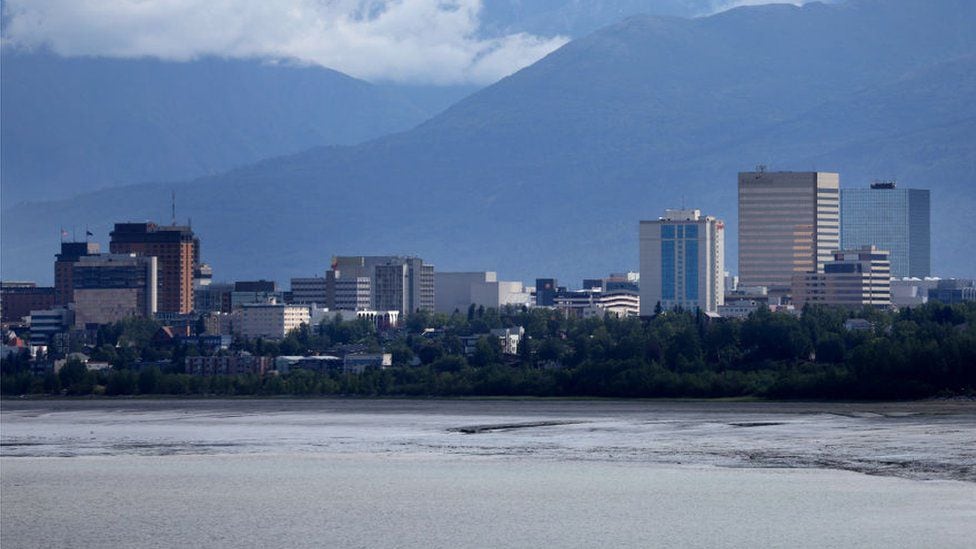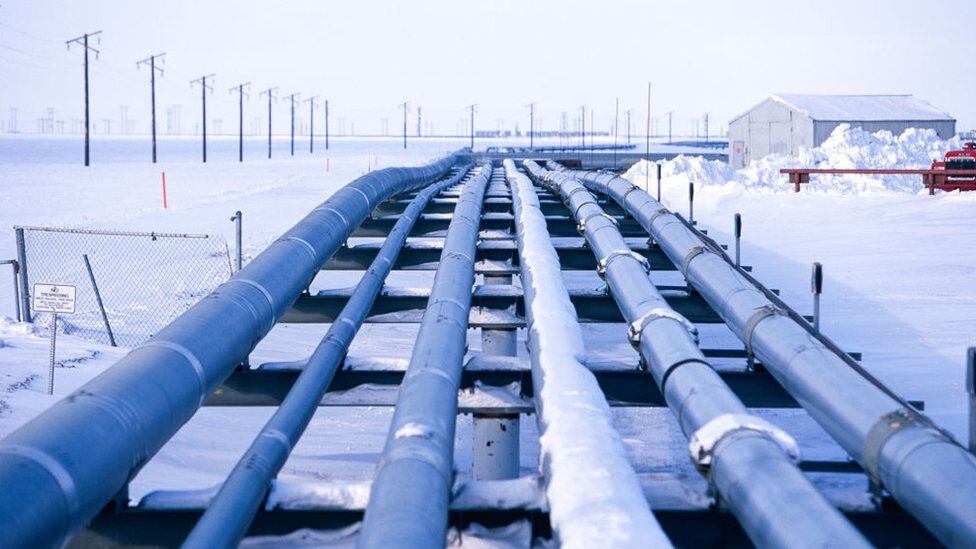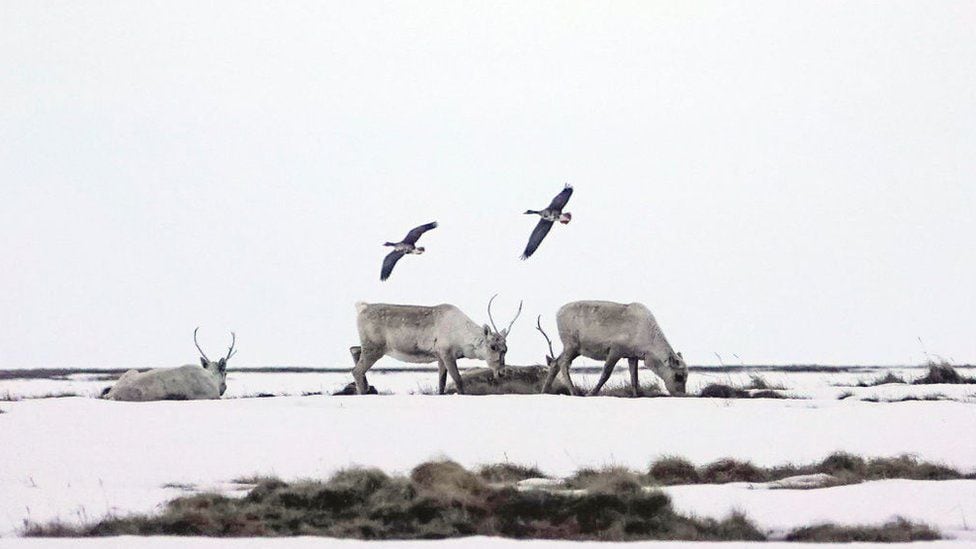:quality(75)/cloudfront-us-east-1.images.arcpublishing.com/elcomercio/GE3DCNZNGA2C2MBTKQYDAORRGY.jpg)
From afar the paradox would seem to jump out at you.
Alaska, one of the places in the world where the effects of climate change are most appreciated and felt, has just embarked on a new oil megaproject, thus helping to increase the production of fossil fuels, a central factor in global warming.
LOOK: What is the controversial Willow Project, one of the largest oil exploitation plans in the history of Alaska that Biden approved
The controversial Willow project, approved by the Joe Biden government this March, expects the extraction of 600 million barrels of oil in the Alaska National Petroleum Reserve, one of the largest areas of wilderness in the United States, located about 300 kilometers from the Arctic Circle.
Your environmental footprint will be palpable. During its 30-year useful life, it is estimated that it will generate some 280 million metric tons of CO2, which is equivalent to putting two million gasoline-powered cars on the US roads each year, according to Office estimates. of Land Administration of that country.
Willow’s environmental impact is seen as unacceptable by environmental groups who see it as a setback in the fight against global warming.
Its approval also comes at a time when the International Energy Agency has warned governments that to avoid the most catastrophic effects of climate change they must stop giving the green light to new fossil fuel projects.
Despite this, Willow had the unanimous support of the Alaska House of Representatives, legislators from both parties representing that state in the US Congress, from most of the indigenous groups in that state, as well as from unions.
Behind these endorsements lies Alaska’s long and complex relationship with the hydrocarbons sector.
What is it about?
A resource that changed Alaska
Alaska began drilling for oil in 1979 and has changed markedly thereafter.
“Oil transformed Alaska. Before this resource was discovered and exploited, Alaska was a relatively poor state with fairly poor public services and an economy that wasn’t growing very quickly,” says Gunnar Knapp, a retired professor at the University of Alaska in Anchorage, who He has spent more than 35 years researching the economy of that state, in conversation with BBC Mundo.
He explains that, from then on, as has happened in many places where they have found oil, that bonanza changed things quickly.
“Suddenly the government has money and that can be good and bad. It can build roads, schools, universities and even give money to people. But that changes the nature of society, the population grew rapidly and maybe not anymore. it’s the same place it used to be, and maybe people aren’t as independent and resilient as they like to think they are anymore,” she adds.
Oil wealth became central to Alaska and for decades was the source of 85% of the state’s revenue.something that began to change around 2013-2014, when it fell due to the combination of a sharp collapse in prices and a decline in production.
According to data from the US Energy Information Administration (EIA), Alaska had its peak production in 1998, when it extracted more than two million barrels of oil per day. Instead, by 2022 its average was just 437,000 barrels a day.
But the importance for Alaska of the so-called black gold goes further.
Taxes, jobs and checks
“The state of Alaska is heavily dependent on the oil industry for its economy,” says Gunnar Knapp.
The expert explains that taxes and royalties paid by oil companies continue to be one of the main sources of financing for the state governmentin a place where it is expensive to maintain a government.

He adds that the oil industry generates many well-paying jobs both directly and through the service companies that support it.
But that is not all.
Since the beginning of oil exploitation, Alaska created a sovereign wealth fund called the Alaska Permanent Fund, in which they have been saving part of the profits generated by the oil boom and that by February 2023 it was valued at more than US$75 billion.
According to Knapp, the oil wealth has allowed Alaska residents to not have to pay income tax or consumption taxes, unlike what happens in other states.
Furthermore, for decades a mechanism known as the Permanent Fund Dividend was established in that state, through which part of the profits generated by investments made with the Permanent Fund are distributed directly and equally among citizens.
“Every Alaskan, man, woman or child receives an equal check. It’s a very popular program among citizens,” says Knapp.
In 2022, each of those checks was for the amount of US$3,284.
Knapp explains that for decades Alaska allocated half of the profits generated each year by the Permanent Fund to pay that dividend, but in recent years due to the drop in revenue in public coffers due to the decline in oil revenues began to use to finance public spending.
How can Willow alter this scenario?
More oil, new income
According to estimates from the Alaska Department of Revenue, Willow will begin generating a positive cash flow for that state’s coffers starting in fiscal year 2030 which will add up to US$4.4 billion by 2043 and US$6.3 billion by 2053.

Municipal revenue for the North Slope, where the project will take place, will begin to see that positive revenue from the time the first property tax is paid in fiscal year 2024 and is estimated to total about $1.3 billion. .
In addition, there will be another US$3.4 billion that will be distributed among the affected communities until the year 2053.
Despite those estimates, experts caution that Alaska may initially lose revenue rather than increase it, due to two factors: Willow will be developed on federally owned land (reducing state benefits because you will not obtain royalties) since the current legislation in Alaska would allow ConocoPhillips, the company responsible for the project, to deduct the investments that it will have to make for it from the taxes it pays for its other active oil exploitations in that state.
Gunnar Knapp believes that Alaska could change this regulation without major difficulties, although he anticipates that the oil company may not like this possibility.

“Assuming you put aside considerations related to climate change, If this tax issue is resolved this project is good for the Alaskan economy, viewed from a very conventional perspective.. It’s not like a miracle, it’s not something that will ‘save’ the state’s economy, but it’s generally positive,” he said.
Beyond the increase in income, the jobs it can create, and the favorable impact it can have on increasing the resources available in the Permanent Fund, Knapp points out that Willow is important to Alaska because, in a way, It is necessary to be able to keep the other oil exploitations that exist in that state running.
“Our entire oil industry depends on the Trans-Alaska pipeline, which carries crude from the North Slope to the Pacific coast, where it is loaded onto ships. But the economic basis of its operation depends decisively on maintaining a sufficient volume of oil flowing through that pipe,” he says.
“But as production has declined – we’re currently at a quarter of what we used to have – it’s getting more expensive to pump crude and there’s even the question that if it continues to fall there could come a time when it would no longer be economically favorable, or perhaps even that it was not physically possible to continue using the pipeline,” he adds.
Put to imagine an Alaska without oil exploitation, Knapp points out that the state still has an important fishing industry, a booming tourism sector and the resources saved in the Permanent Fund, for which he believes that it could survive. However, he thinks it would have to start taxing its residents like other US states do.
“If oil money suddenly disappeared, there would be much less wealth. The economy and the population would shrink and it would be a smaller and poorer place,” he concludes.
Source: Elcomercio
I am Jack Morton and I work in 24 News Recorder. I mostly cover world news and I have also authored 24 news recorder. I find this work highly interesting and it allows me to keep up with current events happening around the world.






